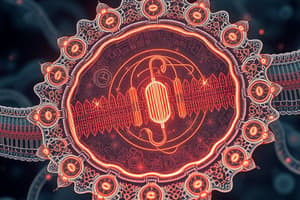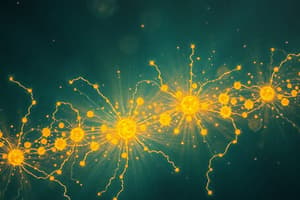Podcast
Questions and Answers
What is the primary factor that determines the resting membrane potential in nerves and muscles?
What is the primary factor that determines the resting membrane potential in nerves and muscles?
What occurs at the Nernst potential for an ion?
What occurs at the Nernst potential for an ion?
Which statement describes the relationship between electrical and chemical gradients for K+?
Which statement describes the relationship between electrical and chemical gradients for K+?
What is the impact of the cell membrane acting as an insulator?
What is the impact of the cell membrane acting as an insulator?
Signup and view all the answers
At what temperature is the Nernst equation typically used for calculations related to K+ equilibrium potential?
At what temperature is the Nernst equation typically used for calculations related to K+ equilibrium potential?
Signup and view all the answers
What does Vm represent in the context of membrane potential?
What does Vm represent in the context of membrane potential?
Signup and view all the answers
Which of the following ions is primarily responsible for establishing the electrical disequilibrium across the cell membrane?
Which of the following ions is primarily responsible for establishing the electrical disequilibrium across the cell membrane?
Signup and view all the answers
How does the electrical force affect K+ ions in relation to the negative charges within the cell?
How does the electrical force affect K+ ions in relation to the negative charges within the cell?
Signup and view all the answers
What is the typical range of resting membrane potentials in animal cells?
What is the typical range of resting membrane potentials in animal cells?
Signup and view all the answers
Which characteristic describes the selectivity of ion channels in cell membranes?
Which characteristic describes the selectivity of ion channels in cell membranes?
Signup and view all the answers
How is membrane potential specifically measured?
How is membrane potential specifically measured?
Signup and view all the answers
What does the Nernst equation calculate?
What does the Nernst equation calculate?
Signup and view all the answers
Which ion has a valency of +1 in the Nernst equation?
Which ion has a valency of +1 in the Nernst equation?
Signup and view all the answers
What effect does selective permeability have on the resting membrane potential?
What effect does selective permeability have on the resting membrane potential?
Signup and view all the answers
At a temperature of 37°C, what value is commonly used for the conversion in the Nernst equation?
At a temperature of 37°C, what value is commonly used for the conversion in the Nernst equation?
Signup and view all the answers
What happens during the gating of ion channels?
What happens during the gating of ion channels?
Signup and view all the answers
Why are ion channels critical in cellular signaling?
Why are ion channels critical in cellular signaling?
Signup and view all the answers
What is the equilibrium potential for K+ calculated when the outside concentration is 4.0 mEq/L and inside concentration is 140 mEq/L?
What is the equilibrium potential for K+ calculated when the outside concentration is 4.0 mEq/L and inside concentration is 140 mEq/L?
Signup and view all the answers
Which of the following ions is NOT typically selective for ion channels?
Which of the following ions is NOT typically selective for ion channels?
Signup and view all the answers
How does the resting membrane potential of skeletal muscle compare to EK?
How does the resting membrane potential of skeletal muscle compare to EK?
Signup and view all the answers
What happens to Na+ at the equilibrium potential when the inside of the cell becomes positively charged?
What happens to Na+ at the equilibrium potential when the inside of the cell becomes positively charged?
Signup and view all the answers
How does the extracellular ion concentration influence equilibrium potential?
How does the extracellular ion concentration influence equilibrium potential?
Signup and view all the answers
Which of the following processes is NOT primarily dependent on changes in membrane potentials?
Which of the following processes is NOT primarily dependent on changes in membrane potentials?
Signup and view all the answers
What is the role of K+ channels during the resting membrane potential?
What is the role of K+ channels during the resting membrane potential?
Signup and view all the answers
Which ion has a higher concentration inside a typical mammalian cell compared to outside?
Which ion has a higher concentration inside a typical mammalian cell compared to outside?
Signup and view all the answers
What is the main reason for the negative charge inside the cell during resting potential?
What is the main reason for the negative charge inside the cell during resting potential?
Signup and view all the answers
Which ions primarily contribute to the resting membrane potential?
Which ions primarily contribute to the resting membrane potential?
Signup and view all the answers
What occurs when K+ channels are open at rest?
What occurs when K+ channels are open at rest?
Signup and view all the answers
What is the approximate extracellular concentration of Na+ in mM?
What is the approximate extracellular concentration of Na+ in mM?
Signup and view all the answers
How does the presence of large intracellular proteins affect the membrane potential?
How does the presence of large intracellular proteins affect the membrane potential?
Signup and view all the answers
What happens to the membrane potential when K+ reaches equilibrium?
What happens to the membrane potential when K+ reaches equilibrium?
Signup and view all the answers
Which of the following statements is true regarding ion distribution in a resting mammalian cell?
Which of the following statements is true regarding ion distribution in a resting mammalian cell?
Signup and view all the answers
Study Notes
Membranes and Receptors Module, Session 3, Lecture 3.1: The Resting Cell Membrane and Potential
- The lecture covers the resting membrane potential in cells.
- The membrane potential is an electrical potential difference across the plasma membrane of a normal living cell.
- Electrical potential is measured in millivolts.
- Animal cells typically have a negative resting membrane potential ranging from −20 to −90 mV.
- Membrane potentials are expressed as the potential inside the cell relative to the extracellular solution.
- The resting membrane potential is crucial for signaling in the nervous system and many other cell types.
Objectives of the Lecture
- To understand the membrane potential in cells.
- To outline how membrane potentials are established and modified by cellular signaling mechanisms.
- To explain equilibrium potential for an ion, and calculate its value from ionic concentrations on either side of the membrane.
Objective 1: Understanding Membrane Potential
- All cells possess an electrical potential (voltage) difference across their plasma membrane.
- This membrane potential is the basis of signaling in the nervous system and other cells.
- The resting membrane potential is the electrical potential difference across the plasma membrane of a living cell under normal conditions.
Objective 2: Establishing and Modifying Membrane Potentials
- Membrane potentials arise from selective permeability of the cell membrane.
- The membrane is selectively permeable to specific ions.
- Permeability to ions occurs through channel proteins (ion channels).
- Ion channels are characterized by:
- Selectivity: allowing only specific ions to pass.
- Gating: opening and closing due to conformational changes in the protein.
- High rate of ion flow down their electrochemical gradient.
Setting up the Resting Potential: Ionic Concentrations
- Intracellular ion concentrations (millimolar):
- Na⁺: 10 mM
- K⁺: 160 mM
- Cl⁻: 3 mM
- A⁻: 167 mM
- Extracellular ion concentrations (millimolar):
- Na⁺: 145 mM
- K⁺: 4.5 mM
- Cl⁻: 114 mM
- A⁻: 40 mM
- A⁻ represents anions other than chloride (e.g., phosphate ions, charged protein groups).
Maintaining Electrical Disequilibrium
- The asymmetric distribution of ions across the membrane creates an electrical disequilibrium resulting in a membrane potential difference.
- The unequal charge separation is essential for cellular function.
- The cell membrane acts as an insulator.
Electrochemical Gradient
- Both electrical gradients and chemical ones contribute to the movement of ions across the cell membrane.
- An electrical force drives ions toward areas of opposite charge.
- Concentration gradient (chemical gradient) leads to movement from high to low concentrations.
Membrane Potential (Objective 1)
- The resting membrane potential for nerves & muscles is from -40 to −90 mV.
- The resting membrane potential is primarily determined by the potassium (K⁺) ion.
Objective 3: Equilibrium Potential
- The equilibrium potential for an ion is the membrane potential at which the net flow of that ion across the membrane is zero due to the balance of electrical and chemical gradients.
- The Nernst equation calculates the equilibrium potential of an ion.
Nernst Equation
-
The Nernst equation, used for calculation: Eion = (RT/ZF) × ln ([ion]out/[ion]in)
-
Constants:
- R = gas constant
- T = temperature (in Kelvin)
- Z = valence of the ion
- F = Faraday's constant
-
Important Considerations:
- The values of the constants are usually pre-calculated for a specific temperature (e.g., 37°C).
- log₁₀ is generally used instead of ln.
Equilibrium Potential Calculation Examples
- A specific example provides the equations and the results to determine the equilibrium potential given cell and extra-cellular concentration of the relevant ions and charges.
- The example calculations are for K⁺ and Na⁺.
Changing Membrane Potentials
- Changes in membrane potential are fundamental in many cellular processes like nerve signaling and muscle contraction.
- These changes can occur from action potentials and triggering muscle contraction to controlling hormone and neurotransmitter secretion to sensory transduction.
Studying That Suits You
Use AI to generate personalized quizzes and flashcards to suit your learning preferences.
Related Documents
Description
This lecture focuses on the resting cell membrane potential, an essential electrical difference across the plasma membrane of living cells. It discusses how this potential influences signaling in the nervous system and details the factors that establish and modify membrane potentials. Attendees will learn to calculate the equilibrium potential for specific ions based on their concentrations.




